Exploring Lapidary Stencils: A Collector's Guide
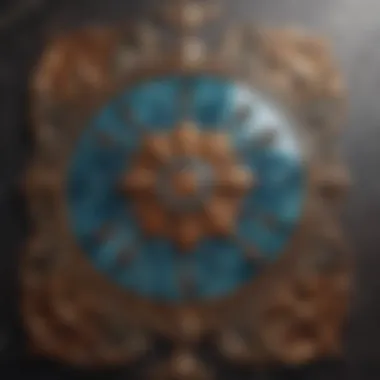
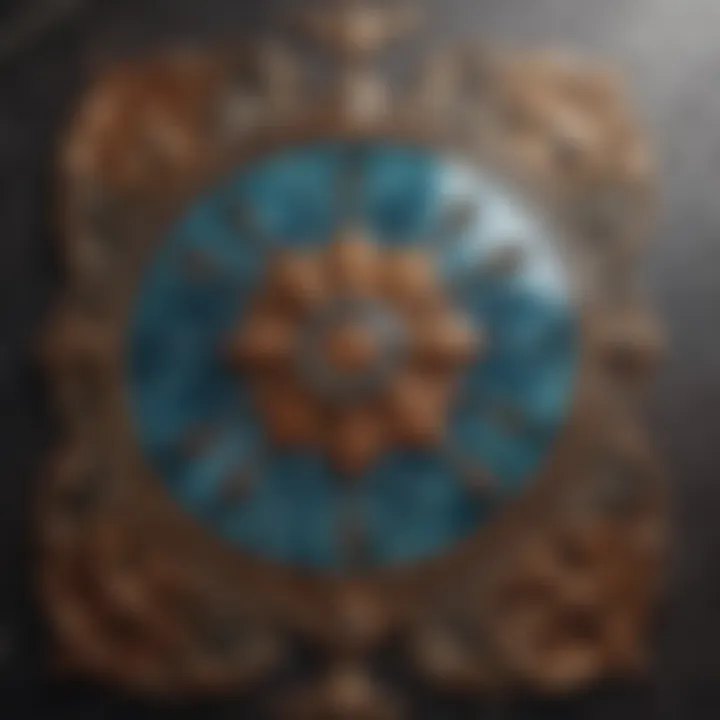
Intro
Lapidary art is a delicate craft that has captivated enthusiasts for centuries. At the heart of this discipline lies the essential tool known as the lapidary stencil. These stencils play a critical role in gem cutting and stone crafting, enabling artists to achieve precision and creativity. In this guide, we will explore the various facets of lapidary stencils, including their types, materials, and the techniques employed in their use. Understanding the history and applications of these tools will deepen your appreciation for the art of lapidary.
Featured Collectible of the Month
Overview
In this section, we highlight a specific collectible that exemplifies the beauty and functionality of lapidary stencils. This collectible is not merely an artifact; it represents a confluence of art and science. By examining such items, collectors can gain insights into the craftsmanship and innovations of different periods. The featured collectible for this month is a hand-crafted stencil that was used in the early 20th century for creating intricate designs in jade.
Historical Significance
The historical context surrounding lapidary stencils is rich and varied. Stencils have been utilized for centuries, with evidence found in ancient cultures that demonstrate their importance in gem cutting. They allowed craftsmen to maintain consistent shapes and patterns, elevating their work from mere practice to an art form. The evolution of stencil design parallels advances in technology, moving from basic hand-carved templates to sophisticated modern tools. This collectible provides a tangible link to that history, illustrating how artisans adapted and innovated over time.
Identification Techniques
Identifying lapidary stencils can be challenging, yet understanding their unique characteristics is essential for collectors.
Visual Characteristics
When assessing a stencil, pay attention to the following:
- The material used (such as metal, plastic or wood).
- The intricacy of the design.
- Any markings or signatures that might indicate the origin or maker.
- Signs of wear that suggest usage in professional settings versus casual crafting.
These visual clues can assist in determining the age and authenticity of a stencil, adding value to your collection.
Resources for Identification
Expanding your knowledge about lapidary stencils can greatly enhance your collecting experience. Here are some useful resources to consider:
- Wikipedia - A general overview of lapidary techniques and tools.
- Britannica - In-depth articles on the history of gem cutting and related crafts.
- Reddit - Community discussions that can offer insights and advice from fellow enthusiasts.
- Facebook - Groups dedicated to lapidary art and tool collecting can provide real-time updates and support.
"Understanding the tools of lapidary art opens a new lens through which to appreciate the craftsmanship involved in gem cutting."
Intro to Lapidary Stencils
Lapidary stencils play a crucial role in the field of gem cutting and stone crafting. These stencils help artisans achieve precision in shaping and designing stones. A well-crafted stencil can transform a rough piece of rock into a meticulous work of art. The importance of stencils lies in their ability to guide the cutter, ensuring consistent results and artistic outcomes. Hobbyists and professionals alike can benefit from understanding how to effectively use stencils in their projects.
Definition and Purpose
Lapidary stencils are templates used to outline or guide the cutting process of gemstones or other materials. They provide a standard form or design that a lapidary artist can follow. The primary purpose of these stencils is to ensure accuracy and uniformity in the final product. By marking out specific patterns, artists can replicate designs and create jewelry or decorative items with great detail.
In practical terms, a stencil allows for complex shapes to be accurately transferred onto a stone surface. This can include intricate designs such as floral motifs or geometric shapes. Using stencils also helps in minimizing errors and inconsistencies that might arise during the manual cutting process. Overall, they are essential tools in achieving high-quality lapidary work.
Historical Background
The use of stencils in lapidary work can be traced back to ancient civilizations that valued gemstones for their beauty and rarity. Historical records show that artisans in cultures such as Egypt, Mesopotamia, and India employed various techniques to shape and adorn precious stones. The evolution of stenciling methods reflects the advancement of tools and technologies over the centuries.
In earlier centuries, masters would carve stencils from wood or stone. As material sciences progressed, so did the development of stencil technology. The introduction of materials such as Mylar and plastic in the 20th century allowed for more durable and versatile stencils. Modern-day lapidary artists benefit from these advancements, using stencils for much greater precision and repeatability than ever before.
"The careful tracing of forms allowed ancient craftsman not only to honor their materials but also to render artistic visions into reality."
Understanding the historical context of lapidary stencils enriches the knowledge of contemporary practitioners. It demonstrates how art has evolved through practices aimed at precision and creativity in gemstone crafting.
Types of Lapidary Stencils
Understanding the different types of lapidary stencils is crucial for any collector or enthusiast in the gem cutting world. The choice of stencil can greatly influence both the precision and creativity in lapidary work. Each type of stencil serves unique purposes and offers varying benefits. This section will cover three key types: template stencils, custom stencils, and digital stencils.
Template Stencils
Template stencils are pre-designed shapes that are used to replicate specific designs consistently. These stencils come in a variety of patterns and sizes, making them versatile for different types of gemstones. Many collectors prefer template stencils since they ensure uniformity in their projects.
Some benefits include:
- Ease of Use: Template stencils are straightforward. They provide clear guidelines for both beginners and experienced lapidarians.
- Time-Saving: With defined shapes, these stencils minimize the time spent on design. This is especially beneficial for serious collectors who value efficiency.
- Quality Assurance: The accuracy of template stencils tends to be high. This feature is essential for maintaining the quality of the final gem.
Custom Stencils
Custom stencils allow for personalized designs that cater to specific artistic visions. They are crafted to meet particular requirements set by the collector or artist. This type of stencil can be made based on individual preferences or unique gemstone features, making them suitable for bespoke projects.
Key aspects include:
- Flexibility: Custom stencils provide room for creativity. Artists can create one-of-a-kind designs that reflect their individual style.
- Enhanced Detail: For intricate patterns or specific designs, custom stencils can achieve fine details that template stencils may not accommodate.
- Tailored Fit: Custom options ensure that the stencil fits the specific dimensions of the stones being used, leading to better results.
Digital Stencils
Digital stencils represent a modern approach to stencil creation, allowing artists to utilize technology in their lapidary work. These stencils are created using design software, offering precision and flexibility. Digital stencils have gained popularity for several reasons.
Advantages include:
- Precision: The digital format allows for exact measurements and intricate designs, which are often difficult to achieve by hand.
- Easy Modification: Changes can be made quickly in digital design programs. This convenience saves time when adjustments are needed.
- Multiple Outputs: Once created, the same digital stencil can be used to produce multiple physical copies. This feature is particularly beneficial for projects requiring several identical pieces.
In summary, the types of lapidary stencils—template, custom, and digital—each support different techniques and artistic visions. Choosing the right type greatly influences the final outcome of lapidary projects.
Understanding these distinctions allows collectors to enhance both the quality and creativity of their work.
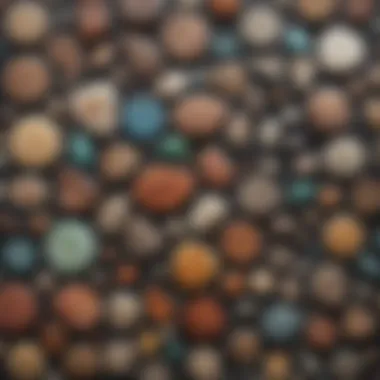
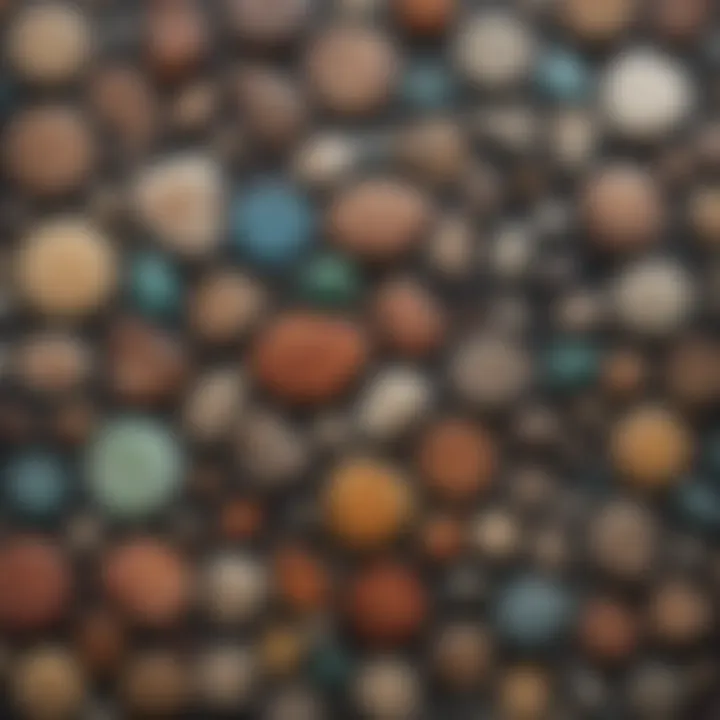
Materials Used in Stencil Creation
Choosing the right materials for stencil creation is a vital aspect of lapidary work. The materials not only influence the precision and durability of the stencils but also impact the ease of use and the final aesthetics of the crafted pieces. Each material has its own unique properties. They vary in terms of flexibility, thickness, and compatibility with various tools and techniques. Understanding these properties allows for informed decisions that can enhance the overall quality of lapidary projects.
Paper and Cardstock
Paper and cardstock are among the most common materials used for creating lapidary stencils. Their accessibility and ease of handling make them suitable for beginners as well as experienced artists. Paper stencils can be easily printed and cut to different shapes. However, their durability is limited compared to other materials.
- Benefits: Cost-effective, easy to customize, ideal for small and simple projects.
- Considerations: Not suitable for wet processes, may tear during repeated use.
When using paper or cardstock, it is advisable to limit use to lighter applications. For example, they work well for marking but are less effective for heavy tool use like grinding or drilling.
Plastic and Mylar
Plastic, particularly Mylar, offers a stronger alternative for stencil creation. Mylar is a polyester film that provides excellent durability. Its resistance to wear and tear makes it ideal for repeated applications.
- Benefits: Long-lasting, waterproof, easy to clean, suitable for both dry and wet applications.
- Considerations: Typically more expensive than paper, requiring precision cutting tools for best results.
The flexibility of Mylar allows it to conform to uneven surfaces, which adds versatility. Artists often prefer Mylar for intricate designs, as it holds up well under the pressure of cutting and grinding.
Wood and Metal
Wood and metal stencils are less common but can provide unique benefits. Wood, for example, is often favored for its aesthetic qualities and sturdy structure. It is easily customizable and suitable for projects that require a more robust stencil design.
- Benefits: Durable, provides a stable cutting surface, can have intricate carvings.
- Considerations: Heavier, not suitable for all gemstone cutting techniques.
Metal stencils, on the other hand, offer the highest durability. They can withstand significant wear and are often used for heavy-duty applications. However, crafting with metal typically requires advanced tools and skills.
- Benefits: Extremely durable, suitable for precision work, can last indefinitely.
- Considerations: Expensive, more challenging to work with.
Ultimately, the choice of material for lapidary stencils depends on the project requirements, desired outcomes, and the artist's skill level. For collectors and hobbyists in the field, understanding the materials will enhance their approach to stencil work, yielding better results.
Techniques for Using Lapidary Stencils
Understanding the techniques for using lapidary stencils is vital for both beginners and seasoned crafters. Employing the right methods not only ensures accuracy in designs but also enhances the final appearance of the gemstones. Each technique has its significance, and mastering them will improve the overall craftsmanship.
Positioning the Stencil
Proper stencil positioning is crucial before any cutting or marking begins. Misplacement can lead to flawed designs, which are hard to correct. Start by selecting the best surface for placement, ensuring it is flat and clean. Consider the size and shape of the stone, as they will influence where to position the stencil. A good rule is to align the stencil in a way that allows for ample space around the design. This helps to avoid any unintentional marks.
Ensure the stencil is securely held in place. Using tape can be effective to prevent any movement during the process. Additionally, implementing a light adhesive spray might assist for more permanent stencils, but always test this on scrap material first. Remember, a well-positioned stencil sets the foundation for accuracy in the next steps.
Marking and Cutting
Once the stencil is properly positioned, the next step involves marking the design on the stone. For marking, utilize a light pencil or fine-tip marker to ensure visibility on different stone types. The goal is to create a guide that helps during the cutting phase.
When it comes to cutting, the choice of tools is paramount. There are various tools available, such as diamond saws or grinders. Each type of stone may require different cutting tools, so be sure to match the tool to the material. Cut along the marked lines carefully, taking your time to avoid mistakes or accidents. Precision here is key, as the quality of the cut directly impacts the finished piece.
"Strategic marking and careful cutting can elevate your lapidary work from ordinary to extraordinary."
Finishing Techniques
Finishing techniques help bring out the beauty of the gem after cutting. After the cutting is done, there will likely be rough edges or marks left on the stone. To achieve a polished look, start with coarser grits of sandpaper or polishing pads and gradually move to finer grits.
Incorporate the use of polishing compounds specifically designed for the type of stone used. Apply the compound with a soft cloth while using a rotary tool or by hand, depending on the size and intricacy of the piece. As you polish, regularly check your progress to ensure uniformity.
In summary, the techniques utilized in using lapidary stencils play a monumental role in shaping the artistry of gemstone crafting. From positioning to marking and finishing, each step requires attention and skill, ultimately affecting the overall outcome.
Precision in Lapidary Work
Precision is a cornerstone of lapidary work, influencing every facet of the crafting process. The art of cutting gemstones requires meticulous attention to detail, as small errors can result in significant consequences. In lapidary stenciling, this precision translates into accurate designs that enhance the beauty and value of the final product.
Importance of Accuracy
Accuracy in lapidary work is vital for several reasons. First, precise cuts allow for the natural brilliance of gemstones to shine through. When stencils are used correctly, they ensure that the cuts are straight and true, maximizing the aesthetic appeal and refractive qualities of the stone. Without accuracy, the stone's potential remains untapped, leading to products that may not showcase their full beauty.
Moreover, achieving precise dimensions is critical in creating designs that fit with other gemstone pieces or jewelry settings. Developers of lapidary stencils must pay careful attention to measurements and angles, as discrepancies can lead to poor fits or imbalanced designs. This can have a knock-on effect for collectors, who seek pieces that harmonize with their collections.
Another aspect lies in the relationship between accuracy and safety. Using stencils to guide cutting techniques minimizes the risk of accidents. A well-placed stencil reduces the need for excessive handling of the stone, making the crafting process safer.
Impact on Final Products
The impact of precision on final lapidary products cannot be overstated. When lapidary artists work with high precision, it enhances the overall quality of their pieces. Accurate cuts lead to clean edges and polished surfaces, which elevate the perceived value of gemstones in the eyes of collectors and enthusiasts alike.
In practical terms, a high level of precision affects several outcomes:
- Enhanced visual appeal: Well-crafted stones catch the light better, showing off their colors and internal patterns.
- Increased durability: Properly cut and polished stones are less likely to chip or crack during use.
- Professional reputation: For artisans and collectors, precision is often synonymous with quality. Delivering items that reflect meticulous workmanship can build a strong reputation and encourage sales.
"In lapidary work, precision is not merely a practice; it is an art form in itself. Successful outcomes rely on the careful embrace of accuracy throughout the process."
Creative Applications of Stencils
The use of lapidary stencils extends beyond mere marking tools; they serve as catalysts for creativity in gemstone design and stone crafting. Understanding the creative applications of stencils is essential for collectors and hobbyists who seek to enhance their work. These applications can significantly influence not only the functionality of the stencils but also the overall aesthetic of the final product.
- Flexibility in Designs: Stencils allow for a multitude of design variations. As artists or crafters, individuals can experiment with numerous patterns and motifs without having to manually draft each one. This variability fosters an environment where innovation thrives, enabling the creation of unique pieces tailored to personal tastes or market demands.
- Efficiency in Production: For those involved in both personal and commercial lapidary work, employing stencils can streamline processes. Using templates ensures that repeated designs maintain consistency in shape and size, lading to a more efficient production time. This standardization is particularly valuable when creating a collection aimed at display or sale.
- Inspiration Geography: The cultural backgrounds of stencil designs often draw upon various artistic influences found in nature or history. Utilizing stencils that embody these motifs can give an additional layer of meaning to each piece. This connection with global art traditions resonates with collectors who appreciate the stories embedded within each creation.
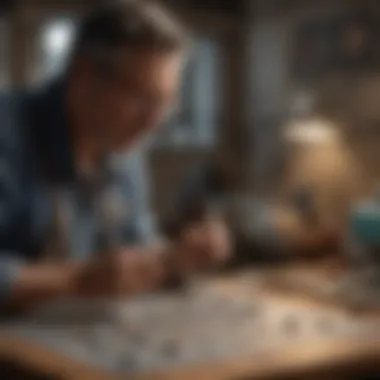
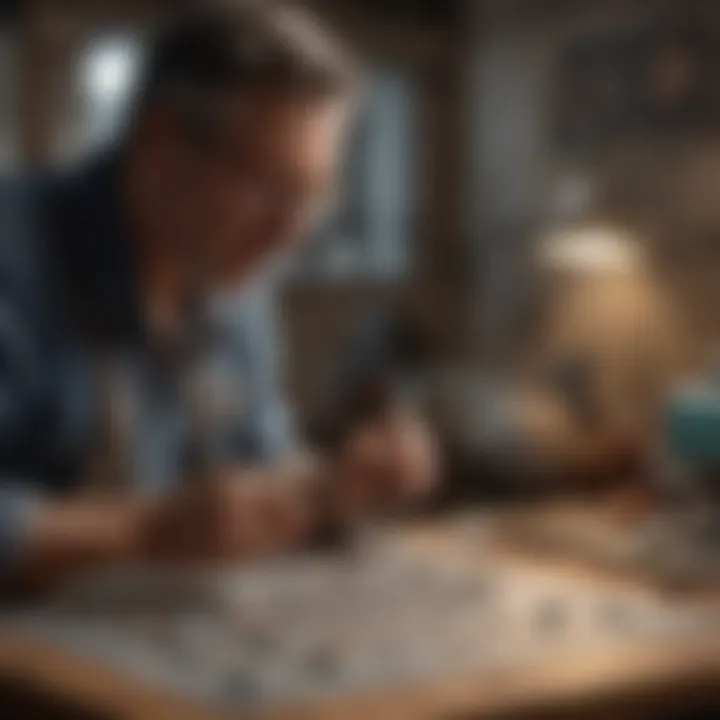
"Stencils in lapidary art not only guide the craftsman’s hands but also ignite the creative spirit," an expert artisan notes.
Design Variability
The aspect of design variability in lapidary stencils cannot be overstated. Stencils can range from simple geometric shapes to intricate organic forms. Each type of design option allows for different artistic explorations within the lapidary craft. Here are key considerations in utilizing stencil designs:
- Patterns: Selecting the right pattern can enhance the character of the gemstone. Whether choosing flowing lines or defined angles, the characteristic of the lapidary piece is often amplified through these stencil designs.
- Proportions: Modifying the proportion of stencil elements can change the feel of a piece significantly. Larger designs may dominate the visual field, while smaller patterns could provide subtle embellishments.
- Customization: Custom stencils enable unique designs tailored to the specific preferences of the craftsman or the intended audience. As artisans create their own templates, they inject individuality into their finished products.
This immense design variability helps artisans differentiate their work in a saturated market, allowing enthusiasts to truly express their creative visions.
Enhancing Gemstone Aesthetics
The aesthetic appeal of gemstones is crucial in lapidary craftsmanship. Stencils play an integral role in achieving artistic outcomes, transforming raw stones into refined works of art. By applying stencils effectively, gem cutters and artists can:
- Create Depth: Layering stencils can add depth to a piece, as variations in color and texture create a multidimensional look. Utilizing transparent materials allows underlying stone characteristics to shine through, enhancing visual interest.
- Highlight Features: Specific patterns can accentuate the unique inclusions or carvings within gemstones. This deliberate selection of stencils highlights natural beauty rather than overshadowing it, promoting the charm of individual stones.
- Unify Collections: Employing similar stencil designs across multiple pieces ensures a cohesive aesthetic among a collection. This uniformity appeals to collectors seeking sets that display both variety and a shared theme.
Ultimately, stencils should not be viewed merely as tools but as essential partners in the creative process. Their applications within lapidary work allow artisans to explore new dimensions of beauty and expression. By considering the aspects listed above, collectors can deepen their appreciation for stenciled lapidary art.
Choosing the Right Stencil for Your Project
Choosing the right stencil for your lapidary project is crucial for achieving the desired outcome. Each stencil type serves a specific purpose and lends itself to distinct techniques. The success of a project often hinges on selecting the correct material and design that aligns with your needs and goals. Thus, understanding the nuances between various stencil options becomes an essential factor in your creative process.
Assessing Project Requirements
Before delving into the wide array of stencils available, it's important to first assess the specifics of your project. Considerations such as the shape of the stone, the level of detail needed, and the complexity of the design will guide your selection process. Here are some key aspects to evaluate:
- Stone Dimensions: Measure the size and shape of your stone. Some stencils are better suited for larger, flatter surfaces, while others excel in detailed, intricate cuts.
- Design Complexity: Simplistic designs may necessitate basic stencils, while intricate patterns could require custom or layered stencils.
- Technique Utilization: The method of cutting or engraving you intend to use should influence your choice. Stencils can complement techniques like hand cutting or machine engraving.
Taking time to thoroughly understand these requirements will streamline your stencil selection process, ultimately enhancing your overall experience and results.
Matching Material Types to Desired Outcomes
Once you have established the project requirements, the next step is to consider the material type. Each material offers different properties that affect the final result. Here are popular materials and their compatible applications:
- Paper and Cardstock: These are typically used for simple, low-precision projects. They are inexpensive and can serve as initial templates to draft designs.
- Plastic and Mylar: These materials provide durability and flexibility, ideal for repeated use. They help achieve cleaner cuts and suit projects requiring repeated stenciling without degradation.
- Wood and Metal: When pursuing very detailed work or rugged designs, wooden and metal stencils offer stability and precision. However, they can be challenging to work with for beginners due to their rigid form.
By matching the material properties with your project's needs, you can enhance the precision and aesthetic appeal of your stenciling approach. Being mindful of these considerations elevates lapidary art, allowing for better execution and satisfaction in your creative endeavors.
"Choosing the correct stencil can be the difference between a simple design and a masterpiece."
Common Errors in Stencil Usage
When engaging in lapidary work, stencils serve as invaluable tools that assist artisans in achieving precision and intricate designs. However, even skilled craftsmen can find themselves making common errors during stencil usage. Identifying and understanding these pitfalls is essential for elevating the quality of work and ensuring successful project completion.
Improper Placement
Placement of the stencil is a critical aspect of the lapidary process. Incorrect positioning can lead to issues that compromise the overall result. If a stencil is not aligned properly with the gemstone or material, the intended design may be distorted or misapplied. This can lead to uneven cuts or unexpected patterns, undermining the aesthetic appeal of the finished piece. Furthermore, improper placement can result in wasted materials, causing frustration and additional costs for the collector.
To avoid improper placement, it is crucial to take time during the setup. A few best practices include:
- Measuring Twice: Always double-check the dimensions of both the stencil and the object to ensure they match accurately.
- Using Adhesives or Weights: Secure the stencil to the workpiece with appropriate adhesives or weights to prevent movement during the process.
- Visual Markers: Utilize visual markers or reference points on the material and stencil for a clearer alignment before commencing cutting or engraving.
Tool Selection Mistakes
Choosing the right tools is fundamental in lapidary work, and mistakes in tool selection can adversely affect the use of stencils. Each stencil may require specific tools to achieve the best result, and using improper tools can lead to damage or unsatisfactory outcomes. For instance, using a blade that is too thick for delicate stencil work may result in jagged edges or torn designs.
Selecting tools demands careful consideration of several factors:
- Material Compatibility: Always match your tools to the material of the stencil and the gemstone or object being worked on. Certain materials require specialized tools for effective use.
- Tool Sharpness: Ensure tools are well-maintained and sharp. Dull tools can cause errors when following the stencil, resulting in messy or incomplete designs.
- Projection Techniques: Understanding the intended outcome can guide the selection of tools. For example, a rotary cutter might be ideal for detailed work, while a saw might be better for broader cuts.
Mattters like improper placement and tool selection are easily underestimated yet crucial to the art form. Addressing these common errors will enhance user efficiency and the quality of the final piece. For anyone involved in lapidary work, these insights serve as essential reminders in the learning process.
Maintenance and Care of Stencils
Effective maintenance and care of lapidary stencils significantly enhances their longevity and functionality. Stencils are intricate tools that play a crucial role in gem cutting and stone crafting. Neglecting them can result in poor results and wasted materials. Proper care not only ensures clarity in designs but also preserves the integrity of the stencil material, whether it be paper, plastic, or metal. Regular maintenance can ultimately contribute to better artistry in lapidary projects.
Cleaning Techniques
Keeping lapidary stencils clean is essential. Dirty stencils can impart unwanted dirt or marks onto the stones. Here are some essential cleaning techniques:
- Gentle Wiping: Use a soft cloth dampened with water or mild soap to wipe surfaces, removing any residue.
- Avoid Abrasives: Do not use abrasive cleaners or scrubbing pads, as they can scratch and ruin stencil surfaces.
- Dry Thoroughly: Make sure the stencils are completely dry before storing, to prevent any mold or degradation of materials.
Effective cleaning maintains precision in your designs, ensuring the stencil can provide consistent results over time.
Storage Solutions
How you store your stencils is nearly as important as the cleaning process. Effective storage can prevent warping, bending, and other damage. The following solutions are recommended:
- Flat Storage: Store stencils flat in a portfolio or binder. This prevents them from becoming misshapen.
- Protective Sleeves: Use protective sleeves, especially for paper stencils, to keep them safe from dust or tearing.
- Climate Control: Keep stencils in a cool, dry place away from direct sunlight. High temperatures can damage plastic and paper materials.
Careful storage practices help in maintaining the structure and usability of stencils. Integrated care routines will enhance both your collection and your crafting skills.
"Proper maintenance of your lapidary stencils can prolong their life significantly and improve the quality of your work, making each gem cut a masterpiece."
By adopting these practices, collectors and hobbyists can ensure their stencils remain functional and effective for years to come.
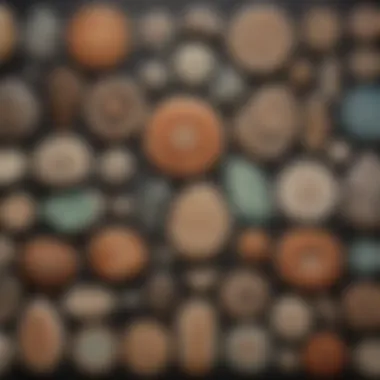
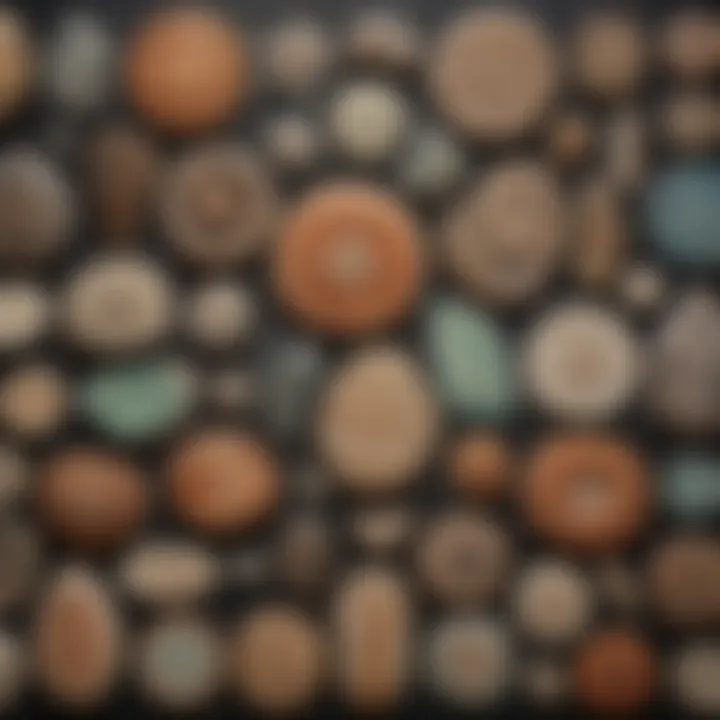
Advanced Techniques in Lapidary Stencil Art
Advanced techniques in lapidary stencil art offer a significant elevation to the craft. Embracing these methods allows artisans to achieve layers of complexity and depth in their work, turning simple designs into intricate masterpieces. Collectors and hobbyists alike benefit from understanding these advanced practices, as they enhance the overall aesthetic appeal of polished stones. Moreover, knowing how to apply these techniques properly can lead to more precise and creative outcomes, which is essential in the competitive world of gem crafting.
Layering Methods
Layering methods represent one of the most dynamic approaches in lapidary stencil application. This technique involves creating multiple layers of design, which can produce stunning visual effects not attainable through single-layer stenciling. When utilizing layering, choose a base stencil as a foundation, which can then be enriched with additional layers over it. Each layer may involve different colors or materials, thus contributing to a more vibrant and intricate final piece.
Consideration is crucial when implementing layering. The alignment of each stencil layer must be precise to maintain continuity across the design. This can be achieved using registration marks, which help to ensure that each subsequent layer adheres to the desired outline without misalignment.
Additionally, the choice of a proper adhesive can significantly influence the outcome. Whether using temporary or permanent adhesives, it should be compatible with the materials being used for layering. The success of this technique hinges upon meticulous planning; thus, experimentation is free to explore and enhance your skills.
Combining Stencil Designs
Combining stencil designs is another advanced technique that adds an innovative dimension to lapidary art. This method involves placing two or more distinct stencil designs onto the same surface, creating a unique fusion of effects. The practice encourages originality, as it allows the artist to craft exclusive pieces that showcase personal style and creativity.
When blending different designs, it is vital to consider the interplay of shapes and patterns. Some designs may complement each other seamlessly, while others might clash. Hence, it is wise to experiment with different alignments and configurations before committing to a final layout. Using transparent stencils can aid in visualizing how the stencils will interact once applied.
Furthermore, the material used for each design can enhance the dimensionality of the piece. Combining textures and finishes can lead to distinctive outcomes, allowing for a more tactile and visually appealing end product. As you explore combining stencil designs, keep documentation of your settings and adjustments. This will serve as a reference for future projects."
Resources for Stencil Creation
In the realm of lapidary work, the accessibility and quality of resources are paramount for both beginners and seasoned crafters. The tools and information surrounding stencil creation can lead to an enhancement in both skill and creativity. The following elements focus on significant resources available to collectors, diversifying options and enabling deeper engagement with the craft.
Online Tutorials
With the vastness of the internet, online tutorials provide immediate and practical guidance for stencil creation. These tutorials can range from basic introductory lessons to complex techniques used by expert lapidary artists.
- Video Platforms: Sites like YouTube host thousands of videos where skilled artisans share their knowledge. Watching a process in action can be more beneficial than reading about it.
- Step-by-Step Guides: Many websites offer well-structured guides that break down the stages of stencil creation. These guides often include images that clarify the process.
- Interactivity: Online forums and communities provide a platform for interaction. Learners can ask questions and receive feedback, enhancing their understanding of the techniques.
The convenience of accessing these resources from home allows hobbyists to experiment with various methods and styles without the pressure of formal settings.
Books and Reference Materials
Books and other printed materials serve as foundational resources for anyone serious about lapidary work. They offer comprehensive information that online resources might overlook.
- Textbooks and Manuals: These often include topics such as materials, safety practices, and advanced techniques. Texts like 'The Lapidary Manual' provide in-depth knowledge from professionals and can act as great references.
- Artistic Inspirations: Many lapidary books also feature showcases of artists’ work. This not only inspires but shows the potential breadth of creative outcome achievable through stencil work.
- Research: Well-researched publications can present historical contexts or advancements in techniques and materials. This background can greatly enrich the collector's understanding and appreciation of the craft.
Books and reference materials can be vital in a collector's toolkit, guiding their techniques and inspiring their designs.
"Resources not only provide knowledge; they foster a community of creators who share their art and innovations in lapidary stencil work."
Collectively, online tutorials and printed materials create a well-rounded educational experience for anyone looking to hone their skills in stencil creation. This fusion of accessible resources ensures collectors remain informed and continually inspire their creativity.
Lapidary Stencil Community and Culture
The lapidary stencil community is a unique subset of the larger lapidary art world. This community thrives on sharing knowledge, techniques, and innovations in stencil use. For collectors and hobbyists, engaging with this community provides not only practical insights but also a sense of belonging. Understanding the culture surrounding lapidary stencils can enhance one’s craft and appreciation for the art, making it an important element of this guide.
Communities and Forums
Online communities and forums are essential for lapidary stencil enthusiasts. These platforms allow members to exchange ideas, ask questions, and showcase their work. Participating in these discussions can lead to discovering new techniques or ways to use stencils creatively. For instance, forums on websites like reddit.com are filled with valuable information, ranging from troubleshooting common issues to sharing success stories.
Key benefits of these online communities include:
- Knowledge Sharing: Experienced users often provide tips and best practices that can save time and enhance results.
- Supportive Environment: New users can receive encouragement and constructive feedback from more seasoned members.
- Resource Recommendations: Members frequently share links to useful resources, such as books, tutorials, or specific stencil products.
Engaging in these online spaces can help cultivates connections with like-minded individuals, enriching the overall experience of lapidary work, especially when tackling stencil challenges.
Exhibitions and Workshops
Attending exhibitions and workshops is another vital aspect of the lapidary stencil community. Such events allow individuals to see various stencil applications firsthand and learn techniques that are difficult to convey through text. It's an opportunity for personal interaction and networking, where artists and collectors can meet, discuss their work, and collaborate.
Workshops specifically focus on hands-on experiences, often led by skilled professionals. Here, participants can learn about:
- Stencil Design: Understanding how to create effective designs for different types of gemstones.
- Cutting Techniques: Acquiring skills for precise stencil cutting and application.
- Artistic Enhancement: Learning how to use stencils creatively to improve the visual appeal of finished pieces.
Additionally, exhibitions often showcase the latest innovations in lapidary tools and stencils, helping collectors stay updated on industry trends. They also serve as platforms for competition and recognition among artists.
Participation in this community is crucial for mastering the art of lapidary stencils. It provides avenues not only for education but also for inspiration.
In summary, the lapidary stencil community and culture are fundamental to both the development of individual skills and the advancement of the craft itself. By embracing the available resources—whether online communities or physical workshops—collectors can significantly expand their knowledge and craft proficiency.
Closure
The conclusion of this article serves as a crucial element in underscoring the significance of lapidary stencils within the broader context of gem cutting and stone crafting. It encapsulates the essential points discussed throughout the guide and emphasizes the multifaceted roles that stencils play in lapidary art. Collectors and hobbyists must recognize that mastering the use of stencils not only enhances precision but also fosters creativity in their projects.
Summary of Key Points
In summarizing the key aspects, the article highlights the following:
- Definition and Importance: Understanding what lapidary stencils are and their purpose in the technique of stone crafting.
- Types and Materials: Exploring the diverse options available, from template to custom and digital stencils, alongside the materials suited for creating them.
- Effective Techniques: The practical methods to use stencils effectively, which can elevate craftsmanship.
- Common Issues: Identifying typical mistakes in stencil usage and how to avoid them ensures better outcomes.
- Maintenance: Proper care and storage methods to prolong the life of stencils.
- Community Engagement: The importance of engaging with communities and discussions around lapidary stencils, enriching knowledge and skills.
Overall, it is evident that lapidary stencils are not mere tools but integral components that can significantly affect the outcomes of projects.
Future Trends in Lapidary Stenciling
Looking ahead, several trends are emerging in the realm of lapidary stencils that collectors should consider:
- Digital Innovation: The integration of advanced software and technology in stencil design is likely to increase. Programs that allow for 3D modeling may simplify the process of creating custom stencils.
- Sustainability: An emphasis on using recycled materials for stencil creation might emerge as environmental concerns grow within the crafting community.
- Educational Initiatives: More workshops and online classes focused on advanced techniques are expected, fostering a new generation of lapidary artists.
- Online Communities: Increased interaction in platforms like Reddit and specialized Facebook groups may lead to collaboration and knowledge sharing, benefiting overall craft standards.
Through these trends, the future of lapidary stencils promises to be both innovative and community-driven, encouraging ongoing learning and artistic development.



